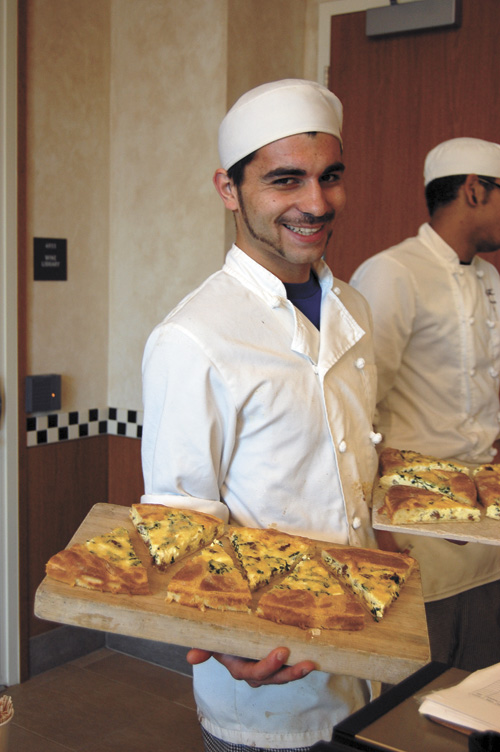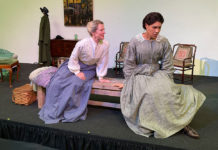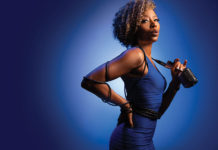When it comes to dicing and slicing, the students in the knife skills class at the Santa Rosa Junior College practice sharp concentration. Along with learning the techniques, they are also in charge of chopping the ingredients that will be used for menu items served at the department’s café. Fresh daily breads, soups, salads and desserts are just a few items students present on the menu for guests who visit their new building on Mendocino Avenue.
The Santa Rosa Junior College Culinary Arts Program moved into their new home across for the Santa Rosa campus at the beginning of the year allowing for more space and up-to-date facilities to meet the ever-growing demand for culinary classes.
“When I started here it was a very small program, 16-unit certificate, no full-time faculty, maybe 15 students working toward certificates and the way the program was organized at that time it was taking them two or three years to complete,” said Chef Instructor and Department Chair Michael Salinger.
Salinger has been around for 20 years watching the program grow from converting the old home economics kitchen into a more commercial space to moving a portion of the classes offered to the Brickyard location in downtown Santa Rosa.
“One of the things I did when I started here was I wrote a grant and rewrote the curriculum for the program changing it from 16 to 22 units and organized it in a fashion that a student could complete in two semesters,” Salinger said.
Eventually the demand for culinary instruction became so great that the SRJC was turning away upwards of about fifty students per class, per semester, deeming the program impacted.
Ten years ago the department began planning for a new space with the long-term goal of building a new building. Five years ago, the process of finding a new home for the program began. Salinger worked closely with the architect to gage the potential growth of the program and to dictate the needs of the facility.
The B. Robert Burdo Culinary Arts Center was completed this January featuring a new Culinary Café and Bakery on the bottom floor and several classrooms and commercial kitchens upstairs.
“You get into a situation when you are building a new building, where do you stop?, I could have built a building two times, three times, four times the size and we could have filled it but when you get too large you start losing quality in my opinion,” Salinger said.
The Culinary Arts Certificate of Achievement trains students in a commercial kitchen as well as front of the house operations and restaurant management. Students learn to prepare stocks, soups, sauces, vegetables, garde manger, entrees, breads, pastries and desserts.
“Essentially what we are trying to do with our program, and it hasn’t changed much over time, is to train entry level and mid-level workers for restaurants, bakeries, catering, all food related industries,” said Salinger.
“We don’t try to train chefs, the private schools will tell you that they are training chefs, I graduated from one of those got a diploma that said I was a chef and then went to work for years as a cook, the reality is that you don’t come out of any school as a chef, it takes years of practice and honing your craft,” he said.
Instead, the program focuses on training students on culinary terminology, being a team member, responsibility, work ethics and proficiency. The program also focuses heavily on local, sustainable and fresh ingredients that come from the SRJC’s 360-acre Shone Farm.
Students interested in a career in the culinary industry can also choose from one of the five certificates: Culinary Arts, Baking, Front House Operations, Dining Room Service and Restaurant Management. Each of these can be completed individually, multiple certificates can be earned or the Culinary Arts Certificate of Achievement can be earned by completing all five.
“Take culinary for example, our students can complete this certificate with all of their books, materials, uniforms, knives, food fees, everything that they have to pay for under $2,500,” said Salinger.
Practical experience is also done in-house through the open commercial kitchen at the Culinary Café rather than through outside internships.
“We would rather have the control ourselves of what the education is that the students are getting and do that through running our own restaurant and bakery,” Salinger said.
The Culinary Café and Bakery is open to the public Wednesday through Friday for both breakfast and lunch. The bakery opens at 7:30 a.m. serving breads and pastries made from scratch by students that morning alongside an assortment of coffee drinks. The café in open from 11:30 a.m. until 2 p.m. for lunch serving wine on Fridays. Reservations are recommended.
“We think of our dining as a white table cloth style, upscale dining. We are trying to train our students to be able to get jobs at the highest level restaurants in the Bay Area,” said Salinger. “One of the really critical things about us is that we are a job training program.”
For more information on enrolling in the program visit www.santarosa.edu/instruction/culinaryarts. For reservations to the Culinary Café call, 522-2796.
PHOTOS: Students enrolled in the Santa Rosa Junior College Culinary Arts Program began training this semester in their new building, B. Robert Burdo Culinary Arts Center 1670 Mendocino Ave. Santa Rosa.
Photos by Robin Hug
Try your hand at culinary classes through SRJC Community Education:
Creative Cake Decorating
April 14, 11 a.m. to 4 p.m.
Work with pastry chef Lorrette Patzwald to learn techniques using marzipan and modeling chocolate. Walk away knowing how to create flowers, bows, drapes and other fancy toppers.
Beginning Cheesemaking
April 15, 11 a.m. to 3 p.m.
Learn the basics with instructor Mary Karlin. Taste samples, make four fresh cheeses to take home.
Playing with Food
May 5, 12 p.m. to 6 p.m.
Nutritious instructions on recipes for people who don’t have time to cook but want to eat healthy.
Secrets to Great Whole Grain Breads
May 6, 11 a.m. to 4 p.m.
Learn what vitamins and antioxidants we get from eating whole grains. Then, mix, shape and bake your own bread.
A Day of Chocolate
May 12, 12 p.m. to 6 p.m.
Study the history, ingredients and production of chocolate. Taste, create and decorate white, dark, milk, truffles and more.
Making Mozzarella
May 20, 11 a.m. to 3 p.m.
Learn to make mozzarella and other stretched curds to share and bring home. These easy recipes can be reproduced for family and friends again and again.
To sign-up for a Community Education classes visit, www.santarosa.edu.
48.8
F
Healdsburg
April 20, 2025








